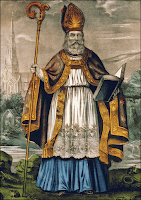 Earthbound devas still wander about, sometimes in human-hybrid form, like at Psytrance dance festivals (Bhakti Omwoods/Facebook). Below: Four leaf clovers are luckier than shamrocks (wisdomportal.com).
Earthbound devas still wander about, sometimes in human-hybrid form, like at Psytrance dance festivals (Bhakti Omwoods/Facebook). Below: Four leaf clovers are luckier than shamrocks (wisdomportal.com). St. Paddy’s Day is the one day of the year when everyone becomes at least part Irish. Who was Saint Patrick, and how do pagans figure into the story?
St. Paddy’s Day is the one day of the year when everyone becomes at least part Irish. Who was Saint Patrick, and how do pagans figure into the story?"St. Patrick" was neither Irish nor born in Ireland. He was Welsh from Wales and lived in circa 385 ACE. Before being designated a "saint" by the corporate Catholic Church, he was a pagan teen by the name of Maewyn. Most people were.
 At 16 he was kidnapped by Irish marauders, who kept him as a slave for six years until, like many jailhouse converts, prisoners under duress, he caved in and converted to Christianity.
At 16 he was kidnapped by Irish marauders, who kept him as a slave for six years until, like many jailhouse converts, prisoners under duress, he caved in and converted to Christianity.After escaping his enslavement, like a newly lost tribe member freed of some pharoah's bondage, he traveled to Gaul where he became a monastic for 12 years.
That intensive "re-education" convinced him that he had to convert the pagans to Christianity. He moved through Ireland for three decades barbarically converting Irish pagans to Christianity by various means, co-opting their holidays, and establishing monasteries (re-education centers) finally dying on March 17th, 461 ACE.
How did Christians convert pagans?
 The interesting question is, How did Maewyn and his Catholic army achieve the conversion of the pagans? By driving away the nagas (snakes, reptilians, demons) or by bringing them onto the Emerald Isle? By casting pagans as demons, rather than the hegemonic church sent in to wipe them out, maybe the snakes were the nature-loving, bhumi-deva (earthbound fairy) honoring pagans.
The interesting question is, How did Maewyn and his Catholic army achieve the conversion of the pagans? By driving away the nagas (snakes, reptilians, demons) or by bringing them onto the Emerald Isle? By casting pagans as demons, rather than the hegemonic church sent in to wipe them out, maybe the snakes were the nature-loving, bhumi-deva (earthbound fairy) honoring pagans. The luck of the Irish is the four leaf clover. But the three leaf variety is far more common, and the folklore is that Patrick used it to teach the Vedic/Hindu-centric idea of the trinity to the new converts. (Strangely that trinity does not occur in the Bible, if that. There are three things, but not the ones usually recited in Vatican-approved catechisms).
The luck of the Irish is the four leaf clover. But the three leaf variety is far more common, and the folklore is that Patrick used it to teach the Vedic/Hindu-centric idea of the trinity to the new converts. (Strangely that trinity does not occur in the Bible, if that. There are three things, but not the ones usually recited in Vatican-approved catechisms).It is such a common feature of Hinduism and its predecessor tradition, Brahmanism, that it is a wonder nobody notices. Brahma has three faces, being three in one, a space shamrock. Other figures -- like wee people or fairies (devas), dryads, gnomes and leprechauns (kumbandhas), snakes (nagas), banshees or unhappy spirits (pretas), bird people (garudas) -- have Vedic, Hindu, and Buddhist parallels. The forest is a magic place for anyone who goes to meditate in it. Just ask Siddhartha, Rumpelstiltskin, or the pre-Patrick pagans.
































































































































































































































No comments:
Post a Comment